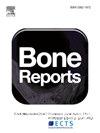High-fat diet induced obesity and anti-activin receptor antibody: Effects on bone properties in mice
IF 2.6
Q3 ENDOCRINOLOGY & METABOLISM
引用次数: 0
Abstract
Aim
Weight-loss therapy often results in an unintended loss of muscle and bone mass. Inhibitors of the activin receptor signaling pathway, such as bimagrumab, an anti-activin receptor antibody (αActRIIA/IIB ab), are under investigation to counteract weight-loss induced muscle loss, but their skeletal effects in obesity remain unclear. This study investigates αActRIIA/IIB ab on bone in mice exposed to a high-fat diet (HFD) model of obesity or standard chow.
Materials and methods
Male C57BL/6 J mice were stratified into four groups (n = 10/group, standard chow or HFD for 10 weeks ± αActRIIA/IIB ab). αActRIIA/IIB ab (10 mg/kg) was administered twice weekly during the final three weeks. The femur and vertebral body were assessed using DEXA, μCT, mechanical testing, and histomorphometry.
Results
HFD did not affect bone density, microstructure, or strength but reduced histological bone formation markers. In standard chow mice, αActRIIA/IIB ab increased trabecular bone volume fraction (BV/TV) and volumetric bone mineral density (vBMD) by 36 %. In HFD mice, the effect of αActRIIA/IIB ab was less pronounced but still increased BV/TV (+16 %) and vBMD (+13 %). For cortical bone, μCT parameters remained largely unaffected by αActRIIA/IIB ab, while the treatment increased periosteal mineralizing bone surfaces in standard chow mice (+217 %), but not in HFD mice.
Conclusions
αActRIIA/IIB ab enhanced trabecular bone properties in standard chow-fed mice, but its anabolic effects were blunted in HFD-fed mice. Furthermore, αActRIIA/IIB ab improved cortical histological bone formation markers, while morphology remained unaffected, suggesting a site- or time-specific difference. Thus, αActRIIA/IIB ab holds potential for mitigating weight-loss-associated bone deterioration.
高脂饮食诱导肥胖和抗活动性受体抗体:对小鼠骨骼特性的影响
减肥疗法通常会导致肌肉和骨量的意外减少。激活素受体信号通路抑制剂,如bimagrumab,一种抗激活素受体抗体(αActRIIA/IIB ab),正在研究中,以抵消减肥引起的肌肉损失,但其对肥胖的骨骼影响尚不清楚。本研究研究了αActRIIA/IIB抗体在高脂肪饮食(HFD)肥胖模型或标准食物小鼠骨骼中的作用。材料与方法将C57BL/ 6j小鼠分为4组(n = 10只/组,标准饲料或HFD, 10周±αActRIIA/IIB ab)。最后3周每周2次给药αActRIIA/IIB ab (10 mg/kg)。采用DEXA、μCT、力学测试和组织形态学对股骨和椎体进行评估。结果shfd不影响骨密度、显微结构和强度,但降低了骨组织形成标志物。αActRIIA/IIB ab可使标准鼠小梁骨体积分数(BV/TV)和体积骨密度(vBMD)提高36%。在HFD小鼠中,αActRIIA/IIB抗体的作用不太明显,但仍能提高BV/TV(+ 16%)和vBMD(+ 13%)。对于皮质骨,μCT参数基本不受αActRIIA/IIB ab的影响,而在标准小鼠中,处理增加了骨膜矿化骨表面(+ 217%),但在HFD小鼠中没有。结论α actriia /IIB ab增强了标准周食小鼠的骨小梁性能,但对hfd小鼠的合成代谢作用减弱。此外,αActRIIA/IIB ab改善了皮质组织学骨形成标志物,而形态学未受影响,表明存在位点或时间特异性差异。因此,αActRIIA/IIB ab具有减轻体重减轻相关的骨质恶化的潜力。
本文章由计算机程序翻译,如有差异,请以英文原文为准。
求助全文
约1分钟内获得全文
求助全文
来源期刊

Bone Reports
Medicine-Orthopedics and Sports Medicine
CiteScore
4.30
自引率
4.00%
发文量
444
审稿时长
57 days
期刊介绍:
Bone Reports is an interdisciplinary forum for the rapid publication of Original Research Articles and Case Reports across basic, translational and clinical aspects of bone and mineral metabolism. The journal publishes papers that are scientifically sound, with the peer review process focused principally on verifying sound methodologies, and correct data analysis and interpretation. We welcome studies either replicating or failing to replicate a previous study, and null findings. We fulfil a critical and current need to enhance research by publishing reproducibility studies and null findings.
 求助内容:
求助内容: 应助结果提醒方式:
应助结果提醒方式:


